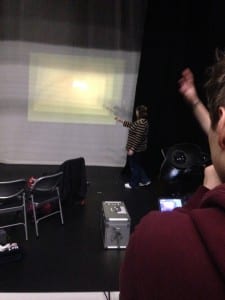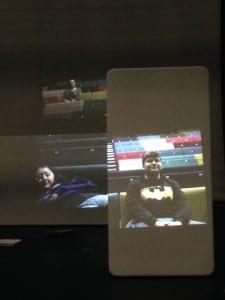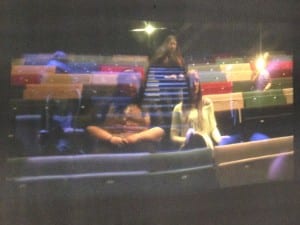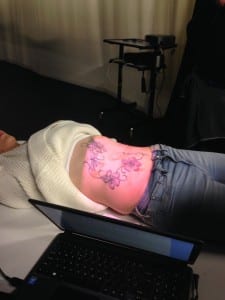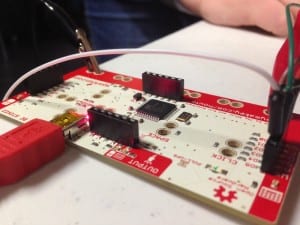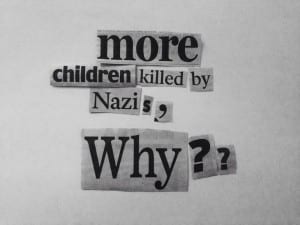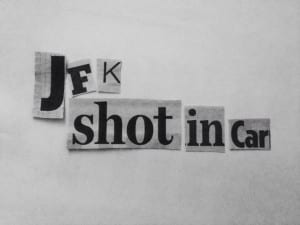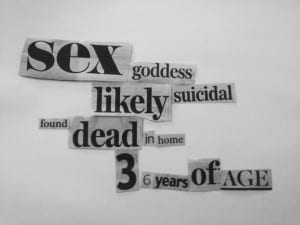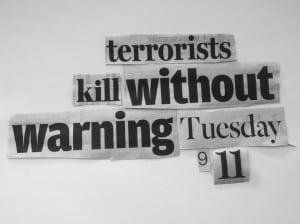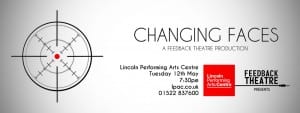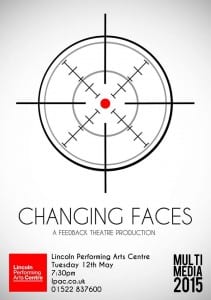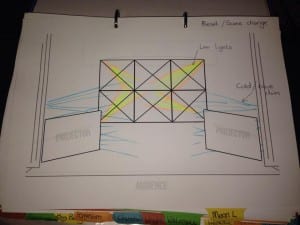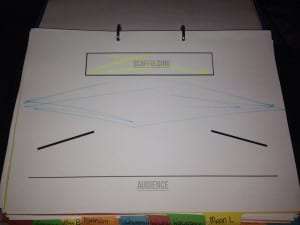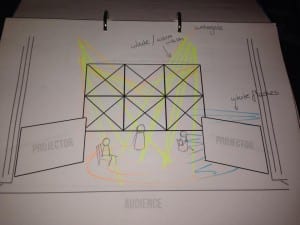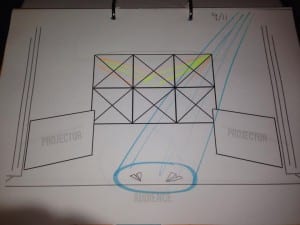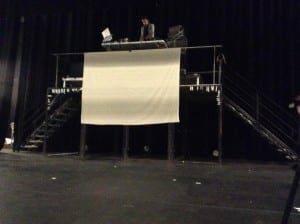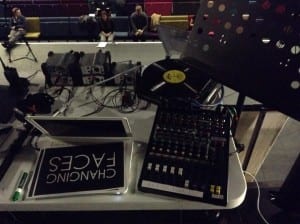So it begins.
These first few weeks have been both daunting and thrilling, in the sense that I have not really had experience in the ways of technology so I chose this module to educate myself further, and to challenge myself in a way that I did not have the opportunity to do so before this module. So I am thoroughly excited to discover if I have any capabilities in the ways of Multimedia performance.
This week we have been looking into Makey Makeys and how they work, along with how they can be incorporated within a performance. So after experimenting with various objects including the human body, using a high five as a trigger and we also succeeded in creating our own version of the game ‘Operation’, another item we experimented with, that was deemed very unsuccessful was the use of chairs coupled with Makey Makeys this probably did not work because the chair itself was in contact with the floor so it did not have a complete, all round connection. We use our bodies for many things, this is no secret, however we have started to use it more in a technological sense; “Sensors such as the Kinect, are readily accessible.” (Hansen, 2013, 136) Using the body as a sensor, as we did when we created the human operation game using Charlotte as the main sensor further proves that we are getting more and adept at using our physical selves to interact with technology.
Another interesting aspect I have learnt this week has something to do with the fact that a theatrical performance always having a beginning and an end, however we are now at a point where we can manipulate and play with time by bringing various points from the past into the present we can create a whole new performance purely by bringing the two separate time streams together. This is just the case in Krapp’s Last Tape, where during his performance he listens to a number of tapes he has recorded in previous years, bringing the past into the here and now. If we think of time as a continuous stack, as if the present is stacked on top of the past, then we visualise removing something from the bottom and placing it on top, thus creating a moment where the past and present coerce.
Time to tinker
This week began with us displaying our short pieces we’d prepared in order to get a slightly better understanding of the various bits of technology that is at our disposal. Our group consisted of three people; we recreated a small scene from Bridget Jones’ Diary by using three different cameras, a television screen and two projections. Our aim was to create the illusion of two people standing directly next to each other, when in fact they are at opposite ends of the stage. After each group had performed their various scenes, those watching then had the opportunity to comment and give feedback to the group, advising them on changes that could be made.
After watching the production of Virtuoso during one of this week’s lessons, it added to my slight fascination of how images can be manipulated to look like something completely different by strategically placing both the objects involved within the shown image and also making sure the person was in a very specific place too. All of these collectively add to creating a final image that can make two people appear to be directly next to one another or create a backdrop from various objects. Although, physically you are able to see each actor, all of the cameras and also all the props on stage, meaning each transition is visible as they move various objects around to create their various images. The fact that each transition is visible and they do not try to disguise it was an aspect I enjoyed and would be something I would quite like to incorporate in our own performance as it gives it a certain aesthetic which I find endearing, just the idea of displaying everything out, making the transitions into part of the show is brilliant.
Creativity and beyond
The beginning of this week brought about the different roles each of us will perform during our creative process. I will be taking on the role of a performer because I’m not great at anything else and feel like I’ll be more of a hindrance than a help at this stage, so I will take any opportunity I can to learn about things bit by bit in the hope that I manage to get some knowledge during our process and start being able to lend a hand to those with other roles as well.
Now that we all know what our positions will be it lead to us doing an improvisational exercise consisting of two individuals who had put their names down to be performers, and speaking along to a projection that had no sound. Improvisation has not really been a subject I have excelled in, maybe due to bad experiences I’m not really sure, but I found it interesting to see where it would lead, working with one other person and seeing what unfolds, some turned to the idea of two people arguing, some made the impression that they were lovers, then some that were just two people having a random conversation. Whichever case, they each brought something different, in my opinion it was depending on who they were paired with and the dynamic those people had, for example, both Chloe and Sam are two very strong willed people so they constantly seemed like they were trying to gain some sort of advantage over the other. So although I do not believe I am great at it, I do feel like I got something out of it.
Ideas in the air
Ideas have started to flow this week. We have begun looking into surveillance and how it affects people on a day to day basis. People act differently when they are aware they are being watched. We are told that we are watched in order to keep us safe, however some believe it more because those with authority just want to spy on us and that they are invading our privacy. There are many films and books that are based around the idea of a higher power controlling entire nations through means such as constant surveillance. Each having its own version of a ‘Utopian’ world which happens to also have constant and privacy shattering surveillance meaning those involved tend to be on edge all the time.
After separating off into smaller groups we came up with rules that we would consider enforcing if we were in charge of our own dystopian future. Many people said they would enforce a population control rule due to it becoming an increasing problem now. After each person shared their rules we came up with the performance idea of creating our own dystopia, with a combination of the rules we have come up with. Creating a supressed civilisation and somehow involving the audience with the goal of making them feeling uncomfortable by displaying images of them on the projectors, seeing themselves become part of the performance will, with any luck, they will feel vulnerable and exposed.
We have come up with a general foundation to which we can expand our surveillance and dystopia idea. G.O.D. is the name of our world dominating corporation; the plan is to create a world around this basis and to see what comes about. We will continue to look into this idea in the coming weeks to see if it takes us anywhere, with more research and ideas for scenes and characters.
Out with the old
Unfortunately the G.O.D. idea did not work out. There was apparently not enough to create a piece with. I think it is a shame I thought the idea had some momentum. The new idea that has been floating about has been one about focusing on history, whether it is various points we focus on or we concentrate on one specific moment. I personally do not believe focusing on one moment alone will be enough, so I have expressed that I would prefer to focus on a number of different snapshots and create a performance out of them. That way we can create a narrative from a number of moments meaning we can create a link between them therefore showing a different variation of events.
Now that we have settled on developing a show around historical moments, we are currently in the process of narrowing down which points of the past we will be displaying. Another aspect that we have decided upon, is that rather than focusing on the pinnacle, well known moment, we will be focusing on the times just before and just after the epic moment; for example, we plan on using the Queen’s coronation as one of our points, however rather than showing her just as she is crowned, we are wanting to develop our own version as to what we think she could have been like in the moment just before she went out to face her nation. Creating such an image of her being shaky and nervous and speaking about her family, and how she misses her father; since the fact she was only 23 when she was crowned is quite a daunting thing especially since that is how old I am and the idea of me being crowned queen is not the nicest of thoughts, the country would go downhill pretty quickly. The fact she must have had a number of emotions just before that epic moment must have been pretty daunting for her.
So this new plan, focusing on the moments behind closed doors that people do not see, just before these iconic historical events take place, this is the new plan. Now that we seem to have a concrete idea for us all to go on now we can really get started with putting something together.
Now the end is near
We have each been assigned a historical moment to look into and to also come up with a way of staging them too. I have been charged with making a scene for Winston Churchill. Attempting to look at his various viewpoints that he expressed throughout his time in parliament , as it varies from loving the war to disliking it quite severly along with his wavering viewpoints towards Hitler; “German sufferings and bitterness marched forward together- as they do to-day.” (Churchill, 2002, 12) I have looked up some famous speeches with the help of Adam and Cherry, the three of us have come up with a rough idea of how we think it should be staged, as the war room with Churchill stood at the head of the table as the room gets built up around him. Now that we have a set scene list the performance is finally coming together.
I have been cast in the suffragettes’ scene, which basically consisted of me sitting down and watching the footage of Emily Davison throwing herself in front of the King’s horse during a race on a seventeen second loop. Until recently where it has been decided that it would be a good idea for me to throw myself on the floor over and over again for the best part of ten minutes. Originally I was quite sceptical about the idea but after doing a run through or two I have received good feedback from people saying it was good and that they had trouble watching which, despite the number of bruises and swollen knee I now have, clearly means it is going well and obviously a good decision to change it from the original idea, although that also had it’s good qualities too. It has now become a more simplistic and hard hitting piece. I have decided my goal is to make people cry on the day of performance, but also to make them think about what must have been going through Emily’s head the moment before running across the racetrack towards the horse; was she scared, determined, thrilled, excited or all of the above. These are things I am wanting to invoke thought with, the act itself must have taken quite a lot of gumption, but that is all people seem to see when thinking of this incident, rather than thinking of her as a person with thoughts and feelings coursing through her merely moments before running.
And so I face the final curtain
We finally have a full production! Everything has very suddenly seemed to be upon us. Although we have not had the opportunity to be in the space with all of the equipment as of yet we have our first chance to have all of the above is on our tech day next week. Although it has been difficult to fully get to grips with everything without access to the space and tech, we are making do. One of the main concerns at the moment is to sort out transitions and to make sure everyone knows where they should be, at what point, and to also make sure it is clear which props and what cameras people would be manoeuvring. Making sure that this was down to perfection so that when we have everything next week we will already know what we are doing, therefore prepared to just get on with it.
Performance day tomorrow! Now we have had our first session in the space with the tech, scaffolding and props. Although the vast majority of the day has been spent going through all of the lighting and setting them up, it has still been helpful to start getting used to the space with the cameras especially, even if that meant just walking through transitions so that everyone was clear of the pace plus how to carry cameras safely. One of the main panics of the day was the lack of fluidity between scenes, so after all the lighting and sound was sorted we spent the last hour or so concentrating on making sure each action was fluid and done with purpose or any dillydallying. Things are looking less like a messy plod and more like an actual production. So most of us are now feeling a bit more confident about the whole thing.
We have finished our show. This entire process has been exceptionally stressful yet in its own way rewarding. It took us a decent amount of time to get going with ideas which is obviously a shared error within the entire group. However we got there in the end, but if I was to do things differently I feel it would have been better to get the ball rolling a lot sooner so we weren’t panicking a fortnight before performance day. I was also worried by the fact I’d not worked with a number of people within the group before this project so I didn’t really know what to expect. Now I’ve come to know everyone and there’s a few I’m going to really miss working with now. I have learnt many things through this process, from discovering that sometimes less is more and also how to work with media elements within a theatrical performance. Overall it has been an all-around learning experience so despite the disorganisation that was our group when we first started, because of that I have learnt something new, and so in a gaining of knowledge standing point I wouldn’t have changed a thing.
Work cited
Churchill, W. 2002. ‘The Gathering Storm’. New York: RosettaBooks.
Hansen, L. 2013. ‘Making do and Making new: Performative moves into interaction design’. International Journal of Performance Arts and Digital Media. 9 (1). 135- 151.

